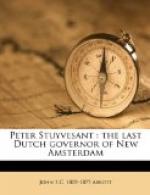In the very able manifesto of the governor, he traced the history of the country from the earliest period to the present time. He deduced the title of the Dutch, to the territory, from the three great principles of Discovery, Settlement, and Purchase from the Indians. He severely denounced the pretence, now put forth by the English, that his, “Britannic Majesty had an indisputable right to all the lands in the north parts of America.” Courteously he added that he was confident that if his Majesty had been well informed in the premises, his high sense of justice would have dissuaded him from authorizing the present hostile demonstration. In conclusion he said,
“In case you will act by force of arms, we protest before God and man, that you will perform an act of unjust violence. You will violate the articles of peace solemnly ratified by his Majesty of England, and my Lords the States-General. Again for the prevention of the spilling of innocent blood, not only here but in Europe, we offer you a treaty by our deputies. As regards your threats we have no answer to make, only that we fear nothing but what God may lay upon us. All things are at His disposal, and we can be preserved by Him with small forces as well as by a great army.”
CHAPTER XIV.
THE CAPTURE OF NEW AMSTERDAM.
The Approach of the
Fleet.—The Governor Unjustly
Censured.—The
Flag of Truce.—The Haughty Response.—The
Remonstrance.—The
Defenceless City.—The Surrender.—The
Expedition to the Delaware.—Sack
and Plunder.—Change of
Name.—Testimony
to the Dutch Government.—Death of the
Governor.—His
farm, or Bouwerie.—War Between Holland and
England.—New
York Menaced by the Dutch.
The only response which Colonel Nicholls deigned to make to the remonstrance of Governor Stuyvesant, was to put his fleet in motion. A party of soldiers, infantry and cavalry, was landed on Long Island, and they advanced rapidly through the forest, to the little cluster of huts which were scattered along the silent and solitary shores of Brooklyn. These troops were generally volunteers from Connecticut and from the English settlements on Long Island.
The fleet then ascended through the Narrows, and two of the frigates disembarked a number of regular troops just below Brooklyn, to support the volunteers. Two of the frigates, one mounting thirty-six guns, and the other thirty, coming up under full sail, passed directly within range of the guns of the fort, and cast anchor between the fort and Nutten or Governor’s Island.
Stuyvesant stood at one of the angles of the fortress as the frigates passed by. It was a critical moment. The fate of the city and the lives of its inhabitants trembled in the balance. The guns were loaded and shotted, and the gunners stood by with their burning matches. A word from the impetuous Stuyvesant would have opened upon the city all the horrors of a bombardment. There were but about twenty guns in the fort. There were sixty-six in the two frigates, whose portholes were opened upon the city; and there were two other frigates just at hand, prepared to bring twenty-eight guns more into the fray.




